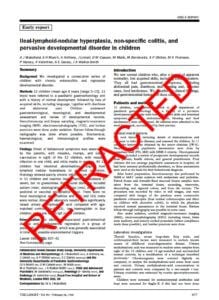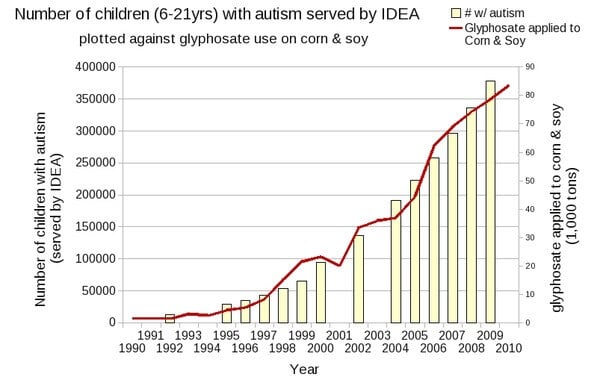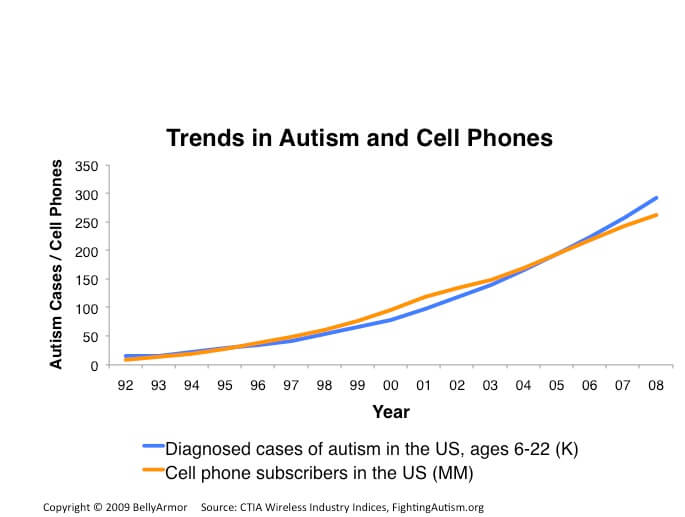It’s been considered a medical puzzle. Mothers, and frankly all of us, are understandably concerned. Considering the numbers, it’s reasonable to ask: What’s causing the rise in cases?
Now researchers believe they know what’s responsible for the bulk of the rise: Nothing. Much of the rise in autism is likely a statistical mirage.
That’s probably not reassuring to parents with children who suffer from the disorder and it’s certainly not the answer you’d find if the Internet is your medical guide. There are literally thousands of articles and hundreds of organizations blaming one thing or another, from vaccines, GMOs and pesticides to even electromagnetic fields, Wi-Fi signals, chemtrails and residential proximity to freeways. Scare headlines are everywhere. Posts like “How I Gave My Son Autism” tell stories of perfectly capable mothers blaming themselves for their child being diagnosed autistic after “exposing” him or her to a vaccine or serving non-organic food.
 A lot of the misinformation flows from a bogus 1998 British study by Dr. Andrew Wakefield that linked
A lot of the misinformation flows from a bogus 1998 British study by Dr. Andrew Wakefield that linked
autism to childhood vaccines. An investigation published by the British medical journal BMJ in 2011 concluded that Wakefield misrepresented or altered the medical histories of all 12 of the patients whose cases formed the basis of the original study, which became the bedrock document of the vaccine denial movement. The study was retracted and Britain has stripped Wakefield of his medical license.
“Meanwhile, the damage to public health continues, fueled by unbalanced media reporting and an ineffective response from government, researchers, journals and the medical profession,” BMJ stated in an editorial accompanying its investigation.
The Genetic Literacy Project has exposed another fraudulent claim that’s raged through cyberspace, blaming autism’s rise on the herbicide glyphosate, which is frequently paired with GMO crops. According to Stephanie Seneff, an MIT computer scientist with no background in agriculture, genetics or epidemiology, half of the country’s children will be born with autism by the mid 2020s because of the increased use of genetically modified crops. Articles carrying Seneff’s videos and comments registered tens of millions of hits.
Now Seneff is endorsing the latest junk “study”, one funded by Moms Across America that claims to have found glyphosate in common vaccines—which she, with no evidence, again links to autism. [The GLP dissects that bogus ‘study’ here]
On the surface, some of these claims seem plausible. After all, the rise in the incidence of autism does track, for example, the rise in glyphosphate use—if you ignore its heavy usage for 20 years (since 1974) before GMOs were introduced (in 1994), and autism rates were steadier.

But correlation is not causation. By cherry-picking the data, one could show that almost all of the alleged causes of autism that rose over the past 10-15 years correlate with the rise in autism cases. As, in fact, does the rise in chemtrail sightings, terrorist attacks on U.S. soil, the New England Patriot’s cumulative win total—and organic food sales:

It also rises with the use of cell phones:
And the rise in B-list actress Jenny McCarthy’s notoriety, which has skyrocketed as she has become a poster girl for promoting scare theories about autism causes.
Because many of the reasons for the increased incidence of autism are unknown, the disorder has become the defacto target for individuals and groups that have little else to point at. As much as the radical fringes of the organic food and everything-natural industries blame Big Ag and Big Pharma for the dramatic rise in autism, they are deftly making the most out of the situation monetarily as well.
So what does the latest evidence show? There now is intriguing evidence that there in fact has been no dramatic rise in autism after all. According to a recent study, scientists at the Aarhus University, in Aarhus, Denmark, assessed more than 670,000 children born between 1980 and 1991 in Denmark, following them from their birth until they were diagnosed with Autism Spectrum Disorder, died, emigrated or reached the end of the study period which was in December 2011. Among other things, Denmark is renowned for its excellent national medical records system, which allowed them to conduct a study of this magnitude and over the extended time span. Among the population studied, 4,000 children were diagnosed as being along the autism spectrum and many of these diagnoses were made after 1995.
Look at what happened just before that detected increase. Tara Haelle reports in Forbes
In Denmark in particular, the diagnostic criteria for autism expanded in 1994 to include a spectrum of disorders with a broader list of symptoms, thereby widening the definition of autism. Then in 1995, national data tracking began to include diagnoses made from outpatient patient visits rather than just diagnoses of those admitted to a healthcare facility.
The exact same thing has happened in every country that has seen soaring autism rates—the definition of what constitutes as autism was dramatically expanded in the early 1990s to embrace the catch-all term Autism Spectrum Disorder—correlating with when GMO usage, chemtrail rates, pesticide exposure and organic food sales began a sharp increase.
The researchers discovered that the change in diagnostic criteria taken together along with the diagnoses made outside of a healthcare facility accounted for as much as 60 percent of the increase in prevalence of autism spectrum disorders. The authors of the study conclude thus
Changes in reporting practices can account for most (60 percent) of the increase in the observed prevalence of ASDs in children born from 1980 through 1991 in Denmark. Hence, the study supports the argument that the apparent increase in ASDs in recent years is in large part attributable to changes in reporting practices.
Though this in itself doesn’t mean evidence of a lack of increase in the prevalence of autism, it does say very emphatically that the huge uptick in numbers of autistic children diagnosed have at least something to do with how we diagnose the condition.
The idea that increased diagnosis contributes to higher prevalence of a disease is not new at all. In fact it is quite common especially as new diagnostic techniques come into play and early screening programs are put in place by governments. This often leads to debates in the medical literature about whether increases in prevalence of disease are real or due to an increase in diagnosis. Prostate cancer is a common example –incidence for prostate cancer jumped more than 100 percent from 1986 to 1992, which coincided with an aggressive expansion of the prostate cancer screening program based on the Prostate Specific Antigen (PSA) test which was approved by the FDA in 1986.
The result of the autism study, even if somewhat expected is still very important. The quality of Denmark’s health records and the size of the study make it unique–it makes the data extremely robust and reliable. So how do these results translate to the United States? We do have similarities in how the diagnosis has changed writes Tara Haelle in Forbes
The way autism is defined in the U.S. has changed dramatically since 1980, when it first appeared in the DSM-III as “Infantile Autism” and could only be diagnosed in children whose symptoms began before they were three years old. Autism spectrum disorders have expanded to include diagnosis without a specific age requirement beyond the “early developmental period” and without requiring significant language impairment in the recently revised DSM-5.
The vast majority of people diagnosed with autism spectrum disorders today would never have qualified under the 1980 classification, and no formal classification separate from schizophrenia existed before then. So it’s not surprising that numbers have increased in the U.S.
There are many possible causes why there is an increase in the prevalence of a disease. Apart from increased screening and changes in diagnostic criteria, factors like increased awareness will also come into play. As credible scientific efforts around the world continue to identify genetic and/or environmental causes behind autism, it is prudent to not be taken in by wild claims and give in to the fears spread by those who accept and promote pseudoscience. And no, the Wi-Fi in your house or the genetically modified foods you eat will not lead to your child becoming autistic.
Arvind Suresh is a science communicator and a former laboratory biologist. Follow him @suresh_arvind
This article previously ran on the GLP on September 22, 2016.

































